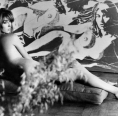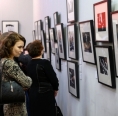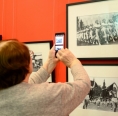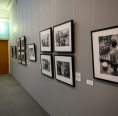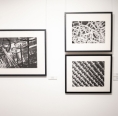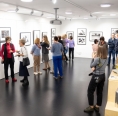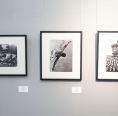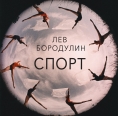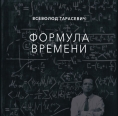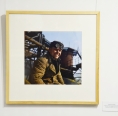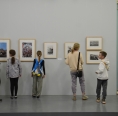-
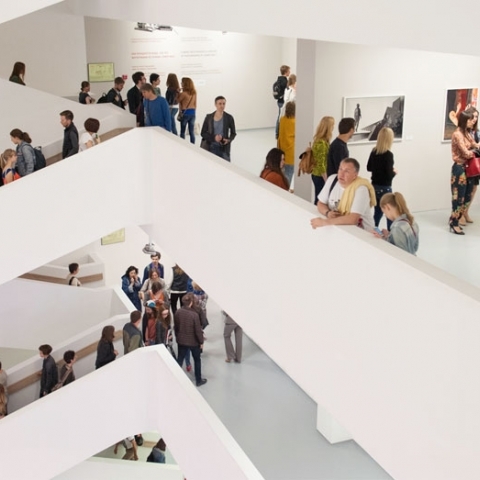
MAMM
Cooperation
-
Address:
Satka
-
Partners:
The Multimedia Art Museum (Moscow) is the largest Russian museum of photography and multimedia arts. It presents over a hundred exhibition projects in Russia and abroad every year.
The museum was founded in 1996 as the Moscow Photography House by the Government of Moscow, at the initiative of Olga Sviblova. In 2021, it became the third most visited art museum in the world.
In cooperation with the Sobranie Fund and the Moscow State Stroganov Academy of Design and Applied Arts, the Multimedia Art Museum presented two major projects in Satka: the exhibition of photos and movie posters Russian Avantgarde and the photo exhibition A Photo Relay Race. From Rodchenko to Our Time. In 2019, the Italian Culture Festival in Satka included an exhibition of works by the famous Italian photographer Elisabetta Catalano. In 2022, the Magnezit Museum and the Magnezit Cultural Centre hosted two exhibitions dedicated to Alexander Rodchenko's work.
2019
The exhibit presents works of Elizabetta Catalano, a famous Italian photographer (1941 – 2015) created from 1964 until 2004: photos made during shooting legendary films and rehearsals of milestone theatre performances, portraits of the world movie industry faces, great film directors, writers and artists, performance photos.
Catalano works is the view from the inside at the fascinatingly interesting events that occurred in the Italian art and culture throughout forty years, precious testimonials of the retiring epoch. Elizabetta was a part of the world she told about in her creativity. She knew characters of her photos, she made friends and worked with many of them. The models trusted the artist; due to this, we can enjoy photos of Federico Fellini, Franco Zeffirelli, Pier Paolo Pasolini, Rudolf Nureyev, Charlotte Rampling, Andy Warhol, Alberto Giacometti, Joseph Kosuth, Fabio Mauri, Umberto Eco, Yevgeny Yevtushenko, Philip Glass and many others in the casual atmosphere – the way they were in a circle of friends and fellow thinkers.
Elizabetta Catalano used to live and work in Rome. Her debut as a photographer took place during the shooting of the famous film of Federico Fellini, «8 ½», in which she played the role of sister of Anouk Aimée, and during the off-shooting time she started making photos. Photos made by Catalano greatly impressed Fellini. So he later used to invite her at the shooting of his films as photographer. Besides, the great film maker repeatedly sat for Elizabetta in her studio, and used some of the photos for front covers of his books.
Career of the young photographer developed very successfully. Catalano worked with influential international fashion magazines such as Vogue, Il Mondo, L'Expresso and others. She had a chance to work with many outstanding artists: Fabio Mauri, Joseph Beuys, Joseph Kosuth, Francesco Clemente, Franco Angeli, Carla Accardi, Mario Merz, Michelangelo Pistoletto, Vettor Pisani and many others.
Curator: Laura Cerubini
The project is provided by the Archive of Elizabetta Catalano
Organizer: Multimedia Art Museum (Moscow)
With support of Istituto Italiano di Cultura in Moscow
2019
This exhibition presents a collection of Soviet and Russian photography built by photographers Yury Rybchinsky and Eduard Gladkov in 1993–2003. They came up with the idea to present their Museum of Photographic Collections to Moscow in 1993 when the first exhibition and presentation took place.
The works of the Museum of Photographic Collections were compiled at the time of greatest interest to the unofficial photography of the 1970s and 1980s. During Perestroika, the photographic history of the USSR was again reinvented, published and defined. The 1920s became its starting point which Rybchinsky and Gladkov determined for themselves as the “time of Rodchenko”. The time when new photography set in. This is how the name of the collection and this project emerged: “Photoestafeta. From Rodchenko to our days”. The basic idea was to show the succession and continuity of the development of photography in spite of political and historical obstacles, to show the development of photography as an art form with a lot of branches and genres, to show the development of photographic vision and its merging with contemporary art.
Today, the Museum of Photographic Collections includes more than 2,000 works with a large number of unique authors’ prints among them.
They did not make preference to a particular style. They tried to be objective. Everything outstanding was worthy of attention. Photo report is one of the main genres of the collection because its authors are professional photographers. And they happened to be present at the point right on the track of this photoestafeta – this photo race. The Soviet Union Magazine (where Yury Rybchinsky used to work) was the successor of the legendary USSR in Construction Magazine. The main artist of the magazine was Alexander Zhitomirsky, a well-known graphic artist, a photomontage master, a follower of John Heartfield and Rodchenko. The best of the best reporters from USSR in Construction – G. Zelma, M. Markov-Grinberg, V. Ruykovich, E. Khaldey, Ya. Khalip – continued to work there. There was an opportunity to learn about other authors through them. It is a materialized milestone of the photo race.
The collectors were attracted by the bright masters of the 1960s who worked in Soviet journalism and are notable for their open views and unique style: V. Akhlomov, L. Bergoltsev, V. Gende-Rote, G. Koposov, V. Tarasevich.
The strength and uniqueness of the collection are attributed to the members of Seeing Different Group who were occasionally published in the 1960s and 1970s and usually made photographs not for the public but for themselves: S. Gitman, V. Kupriyanov, A. Lapin, B. Mikhaylov, B. Savelyev, V. Semin, A. Slyusarev. Rybchinsky and Gladkov belong to this generation.
The collection was created in the midst of Perestroika. Only the brightest regional representatives reached Moscow. Kazan, Cheboksary, Yoshkar-Ola, Kharkov, Minsk: F. Gubayev, Lyalya Kuznetsova, M. Ladeyshikov, S. Osmachkin and others. A separate group consisted of Baltic photographers and new-wave photographers of the 1990s: S. Borisov, V. Efimov, S. Leontyev, I. Mukhin, I. Piganov, A. Shulgin. In 1997, when this collection was supplemented by the masters of the 1920s: A. Rodchenko, B. Ignatovich, A. Shaykhet, it virtually became a sketch of the history of Russian photography, in which achievements, skills, quality and meaningfulness were passed from Rodchenko to our days.
This way is illuminated by seven stops, seven exhibitions. There are collections that are condemned to stay in archives, which the descendants will turn to only three hundred years later. But what we see is another type of collection, the one which has become available to the public with its growth and development. From modern photography exhibitions to retrospection, from documentary images to conceptual photography, from photo installations and photo projects.
The collection reveals different aspects of photography: political, social and documentary, poetic, visual and project. One or another aspect dominated at the past seven exhibitions. One of the first exhibitions – “Russian Dynamics” in 1994 – revealed the actual political aspect of photography. It demonstrated the characters of Perestroika. The Photoestafeta Retrospective in 1997 was devoted to the continuity of the development of photography in all its genres almost for the entire 20th century. “Poetry and Photography” in 1998 emphasized the congeniality of the figurative language and emotional impact of poetry and photography. “Kitsch and Photography Art. Border Situations” exhibition showed the mobile and conventional boundaries between mass culture and its reflection, parody in photography. It was a mix of retrospective and attempts to introduce the features of modern photography. That is why the current exhibition can be represented as a sketch of the history of photography from modernism to post-modernism or from avant-garde to avant-garde.
Early modernist photography emerged from manipulations with the elements of previous styles: pictorialism, assimilation of avant-garde movements up to cubism, suprematism, non-figurative art. Constructive thinking and abstract art logic taught them to see in a modernist way. And it has become a tradition.
Post-modernist photography acquired space and transformed from a print to installation and object. The content and meaning of works became multi-layered and polysemous. By keeping in touch with optical authenticity and documentary photography moved to visual texts, to manipulations with documents, images, to shocking and teasing the audience with its riddles. The most radical experience from this point of view is “The Other Persons’ Photos” project of A. Shulgin. He introduced the objects originally created with completely different objectives as a piece of art: anonymous photographs from technical equipment of exploration teams.
Features of the modern process in art and photographs include permanent reinvention of the artist’s figure, the mythology of their existence, role and appearance. With one or another work, it is not just a cycle or series that is born, but also a new character of the artist, a new way of the art itself, redesigned art area.
These exhibitions allow us to see the moving and changing photography styles in their development. A distinctive visual language is a hallmark not only of the works of individual authors but also of groups, movements, historical stages as a totality of formal and compositional features. Photographers from Rodchenko’s circle are distinguished from earlier masters of photography or pictorialists due to their emphasized constructive, dynamic, structural, large and expressive photo forms.
Photos of the war years 1941–1945 is a tuning fork of truth and fairness of the captured life. The constant presence of the border between life and death. Socialist realism in photos is marked by political and literary overtones, prevailing wide shots, edification. A bright example of this type includes the pictures of V. Khukhlaev from TASS photo chronicle of the 1950s. These are 100% staged photo pictures which are now seen as works in the spirit of Komar and Melamid; they are gravely serious because they depict how the artist came into a shop to a steelmaker or how the Soviet people read newspapers.
At the same time in the 1930s, 1950s and later pictorial style (picturesque photography) existed and developed. It is distinguished by ambiguity, vagueness, uncertainty of the image, which is so desirable in landscape, portrait or still life.
The late 1950s and 1960s, which are referred to as the Khrushchev thaw in the photo collection, had a quite distinct romantic touch and are characterized by mastering live shooting techniques. Life itself was no longer perceived as something prearranged or posed. It turned out that the reality is diverse and heterogeneous. The principle of randomness and spontaneity began to dominate in the composition, which is most evident in the late 1980s.
Against the background of the documentary and event photography of the 1970s and 1980s, the new wave of subjective, sometimes emotionally acute or, vice versa, meditative photographs of still life and urban fragments are characterized by internal tensions.
In the works of conceptual artists, photography becomes a method of documentation of all possible campaigns, as well as an object of redesign. This creates a special space for shooting. And also gives birth to a deliberately sterile and very simple frontal “suprematist” frame, for example, in the works of F. Infante. In other cases, the photo series look like stills from a movie: I. Makarevich with his self-portrait metamorphosis. Yet another group has art direction and accentuated theatricality (Borisov’s works).
“Photographic flow” is constantly pulsating between the two poles of the collection: between reportage and staged, conceptual photography. It seems that time itself is materialized in these pictures. Such a collection of works from different photographic periods of the 20th century is itself a creative product with its own integrity. Likewise, the exhibition will be perceived as a consolidated product belonging to the era of post-modern, the beginning of the 21st century.
A photo is a favorable set of circumstances. The mood of a person, their ability to perceive have to coincide with the place and event at this particular point, which suddenly gives life to a photo. “Those who still appreciate photos for their authenticity and for the fact that they happen by themselves, those are photographers.” Each photographic era has its taste and aroma.
The Museum of Photographic Collections emerged 10 years ago not only to save pictures as art works but also for the sake of promoting the changes in photography coming with each new name. To make each new picture different from the baseline of normal, commonplace, conventional photography. The period to this photo race has not been put yet...
Alexander Lavrentyev
Exhibition venue: Exhibition Hall of Magnezit Cultural Center in Satka.
Photos provided by Multimedia Art Museum, Moscow. Photographers: Arkady Shaykhet, Mark Markov-Grinberg, Evgeny Khaldey and Valentin Serov.
Photo by Vasily Maksimov. Video by Denis Shakirov.
Organized by Multimedia Art Museum.
2022
The unique exhibitions will start on September 15 in two exhibition areas. Both expositions represent photos by Alexander Rodchenko from the collection owned by the Multimedia Art Museum (MMAM, Moscow)
The Magnezit museum will open the photo exhibition “Industrial World with the Eyes of Alexander Rodchenko”.
Alexander Rodchenko is a famous photographer, artist, and illustrator. He was among the constructivism pioneers and creators of the first Soviet advertisement. His original features in artistic photography are still studied and used.
“The Multimedia Art Museum launch an exhibition created by one of the greatest representatives in actual art of the last century — a pioneer in Soviet photography, who became its gold standard already in his lifetime — Alexander Rodchenko,” remarks a fine art expert, arts historian, photo exhibition curator, and a grandson of the famous photographer Alexander Lavrentyev in his texts about the exhibitions. “At present, he is the most popular Russian photographer, in demand in the West, whose pieces of art are successfully exhibited and bought by the largest first-rate museums — MoMa (New-York, USA), the Museum Ludwig (Cologne, Germany), Fotomuseum Winterthur (Switzerland), the Museum of History in Vienna (Austria), the Russian Museum (Russia) and many others. A photo art movement created by Alexander Rodchenko enriched the Russian photography with a number of famous photographers in the 1930-s, such as Arkady Shaikhet, Boris Ignatovich, Mark Alpert.
- He believed that the future belonged to the industrial world,” writes Alexander Lavrentyev. - In the end of the 1920-s, along with printing arts, design, theater, and cinema, Alexander M. Rodchenko (1891-1956) devoted much time to photography. He published his experimental aspect view photos in “Sovetskoye Kino” and “Noviy LEF” magazines, made his first photo reports as assigned by the editors from “30 Dney”, “Radioslushatel”, and “Dayosh!” magazines; “Ogonyok” magazine and “Vechernyaya Moskva” newspaper issued him the photo reporter’s cards. He showed his readers the special world of the new Moscow, buildings created by architects Alexander Vesnin, Moisei Ginzburg, and Konstantin Melnikov. He showed automobile assembly at the Automobile Moscow Association Plant, generators at the power station (the building of the Moscow Association of State-Owned Electric Power Stations was designed by the architect Ivan Zholtovskiy), production of electric lamps. Even a Soviet “kitchen-factory” turned out to be a real plant with its own workshops and technologies in his photos.
The exposition will not only invite the visitors to the industrial world, as it was seen by the famous artisan, but also tell a story — lively, detailed, in the author’s unique manner. “Making a photo report, Rodchenko tried to show all technological operations from point to point. A production process, operation of a radio center or, for example, a newspaper publication process can be reconstructed with his photos,” says Alexander Lavrentyev.
The second photo exhibition — “Moscow in Photos by Rodchenko” — will open its doors in Magnezit Cultural Center.
“The Moscow series by Rodchenko is an endless and intriguing row of city life episodes. Moscow has many faces. Rodchenko saw a historic city with its sightseeing, and new buildings, and ordinary life,” noted Alexander Lavrentyev. - He showed us his own Moscow, where such things as “kitchen-factory”, phone booth or an electric station, a sport parade, a mail van, street trading or a garage of the architect Melnikov were important for him. As an artist, designer, and photographer, he noticed, understood and appreciated these facts first and foremost. This is his city, which is always changing.
The exhibitions will be open till November 1. Admission is free.
OUR INFO:
The Multimedia Art Museum is the largest Russian museum of photography and multimedia arts. Every year it presents more than a hundred of exhibition projects in Russia and abroad.
Cooperation with MMAM continues within the ArtSatka project implemented by Sobranie Fund over several years. In Satka, the Fund organizes events and creative projects, which contribute to gaining knowledge in culture and arts. Let us remind you that the Multimedia Art Museum has previously presented two large projects in Satka in cooperation with Sobranie Fund and the Moscow Artistic and Industrial Academy Named After S.G. Stroganov: the exhibition of photos and cinema posters “Russian Avantgarde” and the photo exhibition “A Photo Hand-Off. From Rodchenko to Our Time”.
Source: Magnezitovets. Photos by Alexander Rodchenko.
2023
Between March 24th and May 28th Magnezit Museum and Magnezit Cultural Center will host the photo exhibitions dedicated to famous Soviet cameraman and photographer Vladislav Mikosha: “Time Machine. Color. 1930–1970s” and “The Arctic. Color. 1930–1970s”. The exhibitions are provided by Multimedia Art Museum, Moscow.
Vladislav Mikosha (1909–2004) is a legendary photographer and cameraman who captured such famous events as the demolition of the Cathedral of Christ the Saviour and the rescue of SS Chelyuskin survivors, the Battle of Sevastopol and the Liberation of Warsaw, meetings of Stalin and Mao, Khrushchev and Kennedy. Holding a camera in his hands for over six decades, Vladislav Mikosha left an enormous number or pictures as witnesses to the stormy times he lived in: frontline footage, photoshoots for Ogoniok and Vokrug sveta magazines, portraits of political and cultural figures.
The twenty-minute color film about the Victory Parade on Red Square, large color photograph series of post-war Moscow and Leningrad, Crimea and the Caucasus, China (1949–1950), Indonesia (1955), Burma (1956), Tbilisi (1951), a series of color postage stamps issued as early as 1940 for the All-Union Agricultural Exhibition — Mikosha was one of the pioneers of Soviet color photography and color did drive the monochrome back in his post-war work.
The exhibition “Vladislav Mikosha. Time Machine. Color. 1930–1970s” in Magnezit Cultural Center will show the color photos of Moscow taken by Vladislav Mikosha in 1930–1970s. Mikosha’s Soviet Moscow will appear before the audience in its full range of emotions and upheavals.
The exhibition “Vladislav Mikosha. The Arctic. Color. 1930–1970s” in Magnezit Museum is divided into three parts: the arrival of airship Graf Zeppelin in Leningrad on 25 July 1931, the SS Chelyuskin rescue mission on SS Smolensk in February–June 1934, departure of the air expedition to North Pole-1 on 21 March 1937. The three series of the exhibition are interconnected not only because of their common author — they share the same intensity, similar characters, equal importance of the moment.
2023
A new exhibition opened in “Magnezit” Cultural Center. It displays art of Lev Borodulin, Soviet photographer.
The exposition resembles a large sports report containing the most noticeable, thrilling, tense and triumphant moments of competitions all over the world. The author of the photos is the legendary sports photographer, classic of Soviet photography, Lev Borodulin. The exhibition is devoted to the 100th anniversary of the master’s birth.
Lev Abramovich was born in Moscow in 1923. In 1940, he entered the arts department of the Moscow State University of Printing Arts and in one year he went off to war. He was seriously wounded twice and received medals “For defense of Moscow” and “For conquest of Berlin”. After the war, he continued studying in the university and became seriously interested in photography. His works were published in student’s newspaper “Stalinskiy Pechatnik”, he worked in the “Sports Life in Russia” magazine and took photos for other publishing houses as well. In the late 1950-s, he became a photo reporter for the most popular magazine in the country – the “Ogonek”. He chose sport for its freedom, and his art became a unique contribution to the history of photography.
– I was a sportsman, played basketball and even played for the Moscow team. Probably, this is how my love of sports photography started. Also, it protected me from ideology and politics, Lev Borodulin used to say.
– His shots became the standard of photo journalism, – this is how he was described in one of the projects of “RussPressPhoto”. – He saw a precise drawing or an intricate ornament in each movement, plastic, lines of arms, he captured the finest feelings and traits of sportsmen. The ability to masterfully “capture” the moment, build the framing, set the accents made the Borodulin’s photos a kind of fine art, an emblem of the epoch.
And the visitors of the exhibition will see these unique moments powerful in their mastery and emotions transferred. There are very graphic photos and photos creating artistic image in the exhibition. For example, the cyclists in “Mexico” photo of 1968 where their group resembles a shape of the guitar neck. By the way, the author compares sport to art in the names of several photos: “Basketball Ballet”, “Sport Graphic” and other. Of course, the visitor is attracted to the “Gymnastic Circle” photo of 1969 which is shown on the exhibition poster. It was made using the fish eye lens with Lev Borodulin being the first one to obtain such in the USSR. He started creating unusual photos.
– He was a wonderful photographer who valued works by other authors as well. Together with his son, he created a remarkable collection of Soviet photography, noted Diana Gurova, representative of Multimedia Art Museum, Moscow, at the exhibition opening. – Of course, his fame was based on sports photos, Lev Borodulin knew how to catch the fleeting emotions and moments. However, not only sports were the object of his art. He took photos of urban landscapes and made social reports. Sadly, the photographer is no longer with us. The exhibition was initially created to commemorate his 95th birthday in 2018, and that was the year when Lev Borodulin passed away. For the 100th anniversary of his birth, we decided to make again the project that sparked so many good emotions and feelings in Moscow and selected photos that can be shown beyond the capital city. We are glad to have such an opportunity. I would like to thank everybody who came here for our little celebration. Within the project, we are planning to organize an online lecture about Lev Abramovich’s art and we will be happy if you participate.
– It is a wonderful exhibition, says “Magnezit” veteran, Vladimir Fedorovich Tataurov. – I played hockey in youth, then got involved in athletics. Besides, there are photos with young coaches of the USSR hockey team, Anatoliy Tarasov and Arkadiy Chernyshev. I have never seen photos by Lev Borodulin before. They are perfect, dynamic, alive. The moments are captured just right. I remember the Moscow Olympic Games of 1980 which I had a chance to attend. I didn’t have time yet to check whether there any photos from the Games. But witnessing such events in reality is immense. Sport is a very beautiful show.
OUR INFO:
“Sport” exhibition is another joint project of Multimedia Art Museum, Moscow, “Sobranie” Fund, Magnezit Group, Satka Region administration and “Magnezit” Cultural Center. It will be open from September 28 to December 3, without holidays, from 10 a.m. to 7 p.m. Admission is free.
2023
The lecture about creative activity of Lev Borodulin, a legendary sports photographer, will be held within the frame of the “Sports” exhibition project displaying the works thereof. The lecture will be held by Nikita Slinkin, an art historian heading the Cultural and Educational Program Division of the Multimedia Art Museum, Moscow (MAMM); the event will take place in “Art-Satka” public creative space on November 14.
The key topic of the creative activity of Lev Borodulin was sports. His photos (part of them is represented in the exhibition hall of the Magnezit Cultural Center) display all the tapestry of feelings and emotional experiences of the sportsman during the competitions. The photographer managed to capture the moments astonishing in terms of beauty and emotional charge, and to convey the intensity of sports emotions; each photo made thereby stated that sports is art, freedom, labor, the world full of dramatic and unforgettable events.
Where were his most famous photos made? Why did he choose the sports photoreport activity? What was the photographer interested in apart from sports? Answers to these and other questions will be given to lecture’s attendees. The lecture starts at 12 o’clock. Online connection is available at https://meet.google.com/ums-gpqh-aju
Let us remind that the “Sports” exhibition will last in the Magnezit Cultural Center up to December 3. Admission is free. Exposition displays the photos taken from MAMM collection. The project is implemented with the support of Sobranie Fund and the Satka District Administration.
2023
Vsevolod Tarasevich is a classic of Russian photography. In 1939, he went to fight at the Soviet-Finnish (Winter) War as a volunteer. In 1941-1945, he worked as a war correspondent. After 1945, Vsevolod Tarasevich worked with the Novosti Press Agency; his work appeared in magazines such as the Sovetskiy Soyuz, Ogonyok, Rabotnitza, and Soviet Life. The latter published photo reports by Vsevolod Tarasevich that he made in the 1960’s and 1970’s at the Moscow State University, the Institute of High Energy Physics at Protvino, the Biophysics Institute of the Russian Academy of Sciences at Pushchino, and in other science centers that were being created at that time.
The period from the late 1950s to the mid 1970s was the time of “physicists vs. lyricists” when science as such and hard sciences in particular were worshiped and promoted. The focus on science and education and the resources spent brought results. Soviet physicists won Nobel prizes: Pavel Cherenkov, Igor Tamm and Ilya Frank in 1958, Lev Landau in 1962, Nikolai Basov and Aleksandr Prokhorov in 1964, and Pyotr Kapitza in 1978. Headlines in the media were filled with words such as “peaceful atom”, “cybernetics”, “genetics” and “space research”. Scientists — and, first of all, physicists — became the heroes of the time.
It was Vsevolod Tarasevich who was the most successful in conveying the image of the science towns of the time: the Akademgorodok in Novosibirsk, the Institute of High Energy Physics at Protvino, the RAS Biophysics Institute at Pushchino, the RAS science center at Chernogolovka as well as the romantic atmosphere that reigned there.
The experience of the era where knowledge and achievement were more important than material reward hasn’t lost its charm to this day.
Olga Sviblova.
2024
An exhibition “Life as a Holiday”, which consists of archival photos published in “Ogonyok” magazine in the period between the 1930s and 1970s will be open from May 22 until July 14 in the Magnezit Museum and from May 23 until July 14 in Magnezit Cultural Center. The exhibition is provided by the Multimedia Art Museum, Moscow.
Since its foundation in 1899, “Ogonyok” made its name as an illustrated magazine: it became the television for the pre-TV epoch, which gathered all family members together. After a pause taken during the revolutionary years and revival in 1923, by 1925 “Ogonyok” has already been published as an edition of 500,000 copies.
This period is a real photo clamor for the country: a photo becomes a powerful visual weapon of the young Soviet regime. The best Soviet masters in photography worked for “Ogonyok”. Photos made by Arkady Shaikhet, Yeleazar Langman, Emmanuil Yevzerikhin, Vsevolod Tarasevich, Issak Tunkel, Mikhail Savin, Eduard Ettinger, Galina Sanko, Dmitry Debabov, Semyon Fridlyand, Lev Borodulin, Lev Sherstennikov and, of course, Dmitry Baltermantz were published on its pages. The latter started working for “Ogonyok” in 1946, and then for a quarter-century, from 1965 until 1990, he headed the photography division of the magazine.
The tradition of the “Ogonyok” photos has been formed in many of its aspects by the history and ideology of the country. A photo is a mirror of our time, but an amalgam of that mirror is determined by the time and changes as it passes. Starting from the 1930s, photography, together with all other types of art, was to follow the principles of social realism. The photographer did not have a task to take a photo “as is”, but “as it was to be”. Photo guides of that period paid special attention to positioning and directing rules, which were to be applied to a seemingly objective photo reportage. Each directed photo becomes a political statement, being both a product and an ideological activity tool at the same time. Using the power of their talent, photographers construct an image of the happiest man in the happiest country. Collective labor feats in fields, plants and construction sites, images of the new reality of everyday life, scenes from a worry-free childhood and well-deserved rest — everything in these photos published in the magazine is filled with the atmosphere of holiday or its anticipation. Together they form a mythological weave of collective happiness.
Its visual canon was finally established by the middle of the 1950s — the flushing time for “Ogonyok” as a photo-illustrated magazine. This is the period, when photos from its cover pages and centerfolds furnish the walls in city apartments, workers’ cabins, soldiers’ barracks, out-patient clinics and cultural centers. This particular time became the “main character” of the exhibition. In the thawing 1960s, an individual happiness starts glimpsing through the veil of the collective holiday — face expressions, plastics, plots and tones of photos start changing. In the 1970s, as the stagnation period comes, a holiday gradually ceases to be the main topic for the Soviet photo art. Therefore, the photos made during these two decades do not take the main places at the exhibition, but draw a line and shade in the aesthetics and the ideological direction of the previous epoch.
The photos made by the Soviet photographers included into the exposition, dazzle us and — as the years go by — at the same time make us think about our past, present and future. “Ogonyok” today is a part of the new media space: reality looks at us from its pages, and it witnesses not only holidays. But one thing remains unchanged — the place occupied by “Ogonyok” in the life of the vast country and in the history of the Russian journalism.
The exhibition is provided by the Multimedia Art Museum, Moscow.
The Multimedia Art Museum, Moscow (МАММ) / the Moscow House of Photography was founded by the Government of Moscow in 1996. It is the first museum of photography and multimedia in Russia. Its director is Olga Sviblova. The collection of the museum contains more than 180,000 depository items. The museum does not show any constant exposition: exhibitions come and go. МАММ represents projects made by the stars in the world and Russian photography and modern art, works done by young artists, as well as video art pieces, VR, performances and art pieces comprising new technologies. Within a year МАММ holds about 60 exhibitions. In addition, the museum provides educational programs in arts for children and adults. Famous artists and photographers give lectures and master-classes in МАММ. Such programs as MAMMcinema, MAMMmusic, MAMMdiscussion are organized in the museum on a regular basis.
Photo by: Vasily Maksimov.
-
2025
Lecture series on art
-
2012
The Russian Museum. Satka
-
2014
FASC

